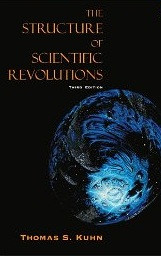
The Structure of Scientific Revolutions
Thomas S. Kuhn
212 pages, The University of Chicago Press, Third Edition, 1996 (originally published 1962)
The first text assigned in my sophomore philosophy of science course at Bucknell University was Thomas Kuhn’s The Structure of Scientific Revolutions. This important work, our professor explained, analyzed the evolution of science and scientific thought. Interesting, I remember thinking. I’d always been taught that science proved things and produced facts, and I was curious to witness this truth-producing process questioned. At the same time, scrutinizing the whole history and process of science seemed aggressive, audacious, even arrogant. And this was precisely what I loved about my philosophy classes: permission to question the unquestionable. By the end of the book, Kuhn had left me with the following concepts:
- Scientists don’t work alone, but as part of scientific communities with sets of agreed-upon beliefs.
- Normal science operates within these sets of beliefs, or “paradigms,” and many scientists’ research is “a strenuous and devoted attempt to force nature into the conceptual boxes supplied by professional education,” as Kuhn puts it.
- Sometimes scientists observe things that don’t fit existing paradigms (Kuhn calls these anomalies), and when enough strong anomalies build up and validate each other, a new paradigm emerges and the old paradigm bursts. These shifts are scientific revolutions, “tradition-shattering complements to the tradition-bound activity of normal science.”
- Scientific revolutions happen slowly. They also threaten the status quo. Remember Galileo, put under house arrest for claiming the Earth revolved around the sun (not the other way around)?
After that year, I found Kuhn’s ideas informing my thoughts about all sorts of things.
Aren’t we all part of communities with agreed-upon, foundational beliefs? Deep down, conscious of it or not, we think we know something about what the world is like, and we gravitate toward others who think similarly. It’s easy to go about our days without stopping to question these fundamental assumptions, though they can limit what we’re capable of seeing and believing is possible. So usually, we’re open to interpreting the world only in ways that perpetuate what we—and our communities—already believe to be true.
Thankfully, anomalies happen. We get shaken up, surprised, or just baffled by life. We get hints that the world might be different from what we’d thought. It’s easy to shun these inklings and to tell ourselves, “No, that can’t be true,” or “I must be crazy,” or “But that’s just not the way things work.” Sometimes, however, the anomalies are true, and we’re not crazy, and we’ve gotten a glimpse of something that could actually redefine the way things work. A well-timed, powerful new insight has the potential to shape an entirely new paradigm around it—shifting the scope of possibility in the world! When I became an MBA student at the Stanford Graduate School of Business, Kuhn’s ideas melded with my studies of innovative organizations and how these organizations create new products, new markets, and in a way, entirely new paradigms. Many begin with a bold, fresh insight about how things could be better—a kind of prescriptive anomaly. They then build themselves around this vision. Sitting in one of Professor Bill Barnett’s strategy courses one day, I realized that this was happening with Kiva, then only a year old: We had seen before us the enormous untapped potential of entrepreneurs’ stories to form connections and inspire action, and we had then used technology and microfinance to build the company around this insight.
Want to start your own revolution? Be aware of your most basic assumptions, and be ready to question them. Keep your eyes open. You might see something new and true. Trust yourself when you do. Follow the insight. It just may be the first step to changing the world.
Jessica Jackley Flannery cofounded Kiva, the first peer-to-peer microlending Web site. She believes that microfi nance, relationships, and stories are powerful tools for change. She holds an MBA from the Stanford Graduate School of Business and a BA from Bucknell University.

